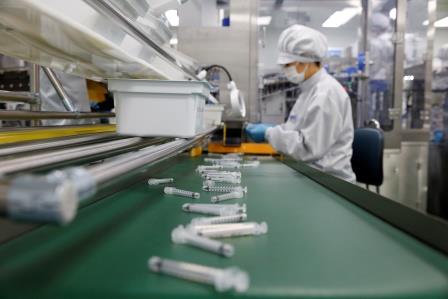LONDON (UK) – Factories across the world are suffering from supply bottlenecks which sent prices skyrocketing in July, while a new wave of coronavirus infections in Asia demonstrated the fragile nature of the global recovery.
Business surveys on Monday highlighted the divergence in the global economy on the pace of recovery from the pandemic, which led the International Monetary Fund to downgrade this year’s growth forecast for emerging Asia.
Although manufacturers largely remained open throughout lockdowns, the loosening of some restrictions designed to limit infections has driven a flurry of demand – but factories are suffering from staff shortages and supply chain problems.
Eurozone and British manufacturing continued to expand at a blistering pace in July as the reopening of economies led to soaring demand, as it did in export powerhouses Japan and South Korea. However, growth in Chinese factory activity slipped sharply.
“The global economic recovery is still on track. The level of activity has been really strong but there have been delays in deliveries,” said Marchel Alexandrovich at Jefferies.
IHS Markit’s final manufacturing Purchasing Managers’ Index (PMI) for the eurozone dipped from June’s record high but was still firmly in growth territory.
The upbeat survey follows official data on Friday which showed the bloc’s economy grew faster than expected in the second quarter, pulling out of a recession caused by the COVID-19 pandemic as curbs to stop the virus were eased.
ASIA STRAIN
In China, however, demand contracted for the first time in over a year, a private survey showed. This broadly aligned with an official survey released on Saturday showing slowdown inactivity.
“Supply bottlenecks remain a constraint. But the PMIs suggest demand is cooling too, taking the heat out of price gains and weighing on activity in industry and construction,” said Julian Evans-Pritchard, senior China economist at Capital Economics.
Indonesia, Vietnam, and Malaysia saw factory activity shrink in July due to a resurgence in infections and stricter COVID-19 restrictions, according to private surveys.
Once seen as a driver of global growth, Asia’s emerging economies are lagging their advanced peers in recovering from the pandemic’s pain as delays in vaccine rollouts hurt domestic demand and countries reliant on tourism.
“The risk is that growth scars linger for longer even if activity recovers in the coming months,” said Frederic Neumann, co-head of Asian Economics Research at HSBC.
“Plus, cooling export momentum, far from a temporary blip, provides a hint of what to expect in quarters to come,” he said, adding that such uncertainty over the outlook would prod Asian central banks to maintain the loose monetary policy.
The final au Jibun Bank Japan PMI rose to 53.0 in July from 52.4 in the previous month, though manufacturers saw input prices rise at the fastest pace since 2008.
Japan also faces a surge in Delta variant cases that have forced the government to expand the state of emergency curbs to wider areas through Aug. 31, casting a shadow over the Olympic Games and dashing hopes for a sharp rebound in July-September growth.
South Korea’s PMI held above breakeven for the 10th straight month. But a sub-index on input prices rose at the second-highest on record.
While still grappling with infections, easing restrictions helped India’s factory activity to bounce back in July as demand surged both at home and abroad.
#bh #bhmagazine













